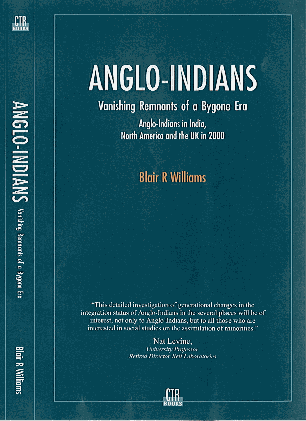
The Anglo-Indian Community, particularly in the context of post-Independent India, has been the subject of several studies carried out by University academics in Australia, the United States, Canada, Britain and India. The latest of these, a publication entitled Anglo-Indians - Vanishing Remnants of a Bygone Era by Blair Williams, (himself an Anglo-Indian) is an examination of the Community as it stands on the threshold of the 21st Century.
As suggested by the title it comes as no surprise to most Anglo-Indians who were part of the Diaspora following India's independence in 1947, that the Community's ties to a singular culture and way of life in India are now rapidly dissolving. Williams' investigation is an illuminating study of the process of assimilation, and the factors determining the changes which have overtaken the Community over the past half-century.
The author's conclusions are based on the results of a survey carried out in India, Britain, Canada and the USA, in addition to a series of personal interviews with a sampling of Anglo-Indians in all four countries. It encompasses a broad range of reference material and discusses not only the historical, cultural and economic factors that shaped the Community in India, but also the attitudes, loyalties and values which were intrinsic to the Anglo-Indian way of life. Tracing ethnic origins and marriage patterns within the Community necessitated a painstaking investigation of church records in India, and the results of this, combined with a multitude of other research data, has taken Williams the better part of three years to classify and distill.
Much of the material is in the form of statistical tables and charts. Quantitative analysis is, of course, a practical tool for presenting socio-economic facts. However, numbers neatly arranged within columns do not necessarily tell the whole story. It is to Blair Williams credit that he has included a series of comments arising from his discussions with Anglo-Indians in India and in the West, on a variety of issues - i.e. how they perceive themselves in relation to other communities, their pride of identity (or lack thereof), opinions in respect of education, careers, gender roles, responsibilities and future prospects. The responses from Anglo-Indians who have stayed on in India are particularly revealing. Their reactions range from bitter-sweet nostalgia to insouciant optimism. In any event, they mirror the daily problems and concerns of a miniscule Community who, by and large, are content to integrate into the larger fabric of Indian society in terms of language, dress, social interaction and choice of Indian marriage partners. It is a coming of age that would have been unthinkable fifty years ago.
As Williams readily admits, the study is not all-encompassing. In India the subjects of his interviews are mainly middle or upper class Anglo-Indians, who for the most part live in urban areas, or in large cities such as Calcutta and Madras. Their comments, however, are fairly typical and by extrapolation it would not be unreasonable to assume that they are a reflection of the opinions held by the majority of Anglo-Indians living in India today. The sampling of Anglo-Indians living in England, Canada and the USA is also relatively small, with very few respondents in the under 30s age group. This, in itself is a telling indication of the attitude of the younger generation towards a culture, which no longer evokes a meaningful sense of identity.
The Anglo-Indians were - and still are - a complex community. They are fissiparous and have strong views and stronger tempers, which have been an impediment to unifying the Community under the banner of even as august a body at the All-India Anglo-Indian Association. Yet despite this, they cherish old friendships, are nostalgic about schooldays and delight in sharing a commonality of background and tradition no matter where they live around the globe. As Anglo-Indians - Vanishing Remnants of a Bygone Era demonstrates, the Community will eventually die out. Nonetheless, as evidenced by the enthusiastic attendance at International Reunions, (and a proliferation of sites on the world wide web) the Community is not moribund yet. If anything, there is a resurgence of pride in its past, and an energetic will to nourish the embers for as long as the glow continues to warm the memories of those who were born and lived in a very different India in the mid 1900s.
In this context Blair Williams' book is both timely and relevant, providing as it does an absorbing insight into the process of change and assimilation. Anglo Indians and non Anglo-Indians alike will find it a compelling and informative study of a little known Community which played an important, if unsung, role during three centuries of British rule in India, but whose existence today is as ephemeral as the grandiose Empire that spawned it. existence today is as ephemeral as the grandiose Empire that spawned it.
 DETAILS:
DETAILS:
Expected availability - July 15th 2002
Suggested Price: $10.00 US; $15.00 CA; $20.00 Aus; L7.50; Rs 350 (add 10% for P&H )
Orders:
*In North America, email Blair at blairrw@att.net (watch the two r's)
*In the UK, Australia - Send letter and check to persons below.
Payment: Send check to:
*In Canada: CTR c/oY.Peters, 51 Brook Av., Toronto, ON M6K 2L3
*In the USA: CTR, PO Box 6345, Monroe Twp. NJ 08831, USA
*In the UK: CTR c/o Ms J.Chambers, Solvent Breezes, Warsash Hants SO31 9H6
*In Australia: CTR c/o M.Goss, 26 Kyarra Road,Glen Iris, Melbourne Vic 3146*In India: CTR c/o J.Gardner, Laidlaw Memorial,Ketti, Tamil Nadu 643215Gross Proceeds to Charity - CTR - Helping less fortunate Anglo-Indians in India Questions: blair williams
Back to Anglo-India Memoirs Page